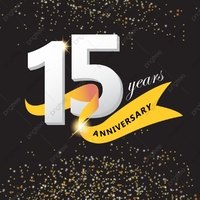Karl Ritter's banned 1943 military film Besatzung Dora (Air Crew Dora) – Special Section.
Deutscher! Wir suchen mehr Materialen über den BESATZUNG DORA (1943). Haben Sie etwas zu verkaufen? Bitte unten weiter lesen.... Besten Dank im Voraus!
We proudly have published the first–
ever book on this remarkable WWII
combat feature film, shot with an all–
star cast on active war fronts between
July and December 1942!
The feature film Besatzung Dora was the last military combat feature film of the Third Reich*, completed in January, 1943 but after months of editing, re–editing, and private screenings, ultimately forbidden officially. The film was shot entirely on location on the Western Front, in Berlin, in the Soviet Union, and in Italy in 1942. The Italian scenes were meant to have been filmed in the active war zone in North Africa but by the time the production company was finished in the USSR, Rommel had exhausted his fuel supplies and the Allies had cracked his military codes, so the Afrika Korps had been defeated and North Africa was off limits. In addition, the Battle of Stalingrad had been lost in February '43 and the film plot had a Luftwaffe airman promise his fiancée a new farming life 'in the East' when the war was won. The film also had the Italians rescue the German airmen after a crash landing in North Africa, but by the time the film had been edited and readied for release, Mussolini had been overthrown and Italy no longer an Axis partner of the Reich.
* The unreleased 1944 film, Eine kleine Sommermelödie, was filmed in Berlin and on the holiday island of Sylt, not in an active war zone, and the single scene of "war" was a trench scene which cannot be distinguished as either on the Eastern Front, nor the Western Front; and the unfinished film Das Leben geht weiter, on which Karl Ritter was Head of Production, was meant by Dr. Goebbels to be a look back -- after the Endsieg -- at the terror bombing of Berlin's civilians by the Allies, so can hardly be considered a "combat" film, unless one equates bombing civilians with napalm and cluster bombs as equivalent to a battle between two armed forces, such as Leningrand or Stalingrad.
" The creation of a war film is endlessly more difficult than that of a conventional feature film. Because afterwards comes the criticism of millions of movie viewers who are themselves in combat life. A war film shot in the film studio, as the British and especially the Americans have already done, would just trigger laughter from the German soldiers. What someone has experienced and lived through day in, day out, doing what one can and must do, nobody wants to see that as film kitsch. A real war film can therefore only stand up to the assessment if it is shot in a 'real environment,' as the filmmaker says. That is why Professor Karl Ritter, who is himself an officer in the Luftwaffe, came to the harsh reality of the Eastern Front with his Production Company, to film his new aviation film “Besatzung Dora.”
– quote from the military magazine "Flieger, Funker, Kanoniere Frontzeitung einer Luftflotte" - Folge 35/36 - Dezember 1942.
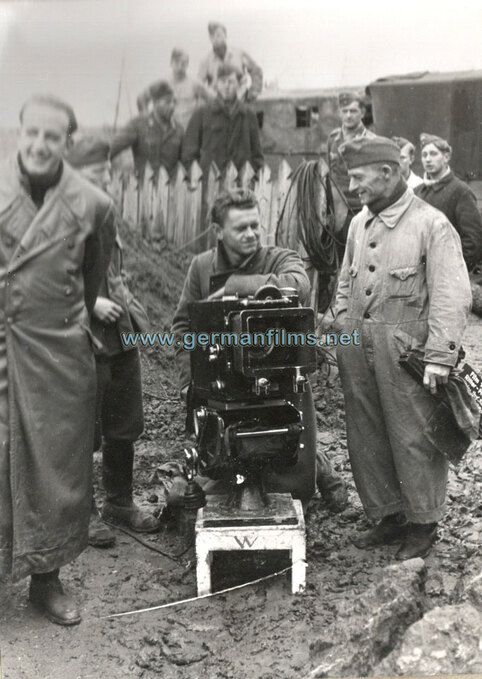
ABOVE: Filming conditions in the Soviet Union in October 1942 were vile. The production weeks there were filled with poor weather, rain, mud, and filth, and the start of Winter with snow. This photograph is from an unknown Wehrmacht solder's personal wartime album, showing the 35mm camera used in filming. Gottfried Ritter, the youngest son of Carl, and the film's Assistant Director and Editor, is shown at the very left of the photo.
BELOW: A Dora scene filmed in October 1942 at the Luftwaffe's airbase at Gostkino, in the Occupied Soviet Union, some 136 kilometers south of the on–going Siege of Leningrad, from our collection of fourteen rare original lobby cards (and 7 press photos) from the film.
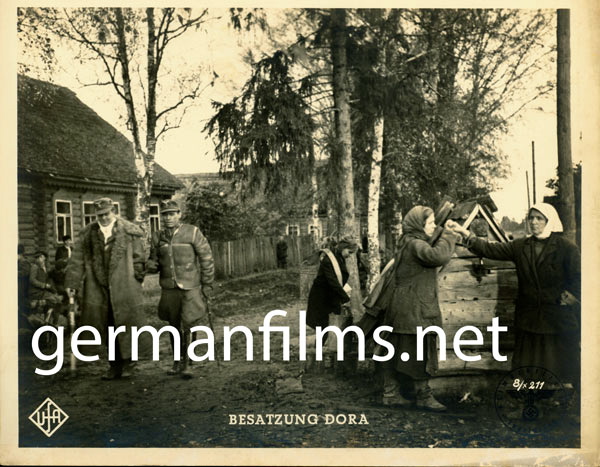
In researching the 2nd edition of the first biography written on Karl Ritter, new primary information about the film and background on its production and evolution was obtained courtesy of Karl Ritter's family.

Right: The work desk where Karl Ritter's private diary pages pertaining to his last propaganda film, BESATZUNG DORA, written in old Sütterlin handwriting, were studied and translated for inclusion in the 2nd edition of the Gillespie book on the film director.
Ritter's unpublished diaries were studied, maps that Ritter sketched in the USSR and photos taken at the time of the filming were accessed, as well as rare film ephemera, such as the cinema owner's guide (Werberatschlag) to the film issued by the Ufa film studio, shown below on the left. . This brochure included not only marketing suggestions about the film, but a B&W image of the proposed film poster, which was never printed, in the end. The second brochure on the right is the Ufa studio's pressbook on the film, with background articles, interviews, and promotional materials for the film.
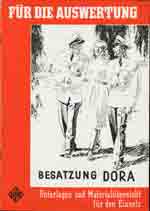
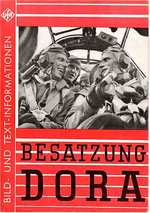
All relevant issues of the Film–Kurier Tageszeitung, the magazines Filmwelt and Filmwoche, the Viennese Tonfilm – Theater – Tanz, the Ufa flm studio's internal Ufa Feldpost newsletter for employees serving at the Fronts, and the Reich Film Chambers' own Der Deutsche Film journal were quoted, such as this first mention of the film below:

A private photo album compiled by a Luftwaffe officer who took part in the filming of Besatzung Dora in Gostkino near Luga, USSR in October 1942 was obtained by the Collection in mid–2014, and a leaf of the album is shown here, of airmen and ground support staff lining up for the film scene where the 2000th sortie against the enemy is being celebrated.
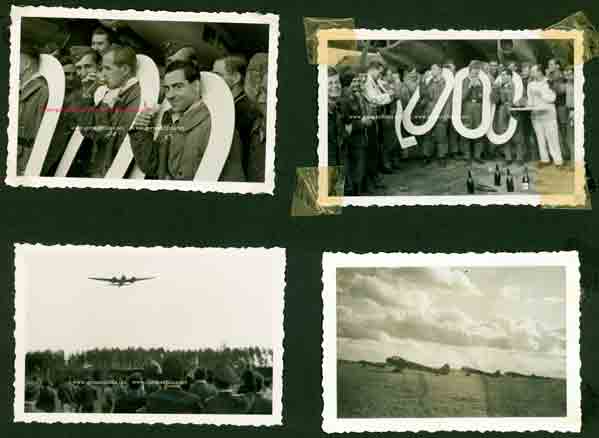
Here is how that scene eventually appeared in the film itself:
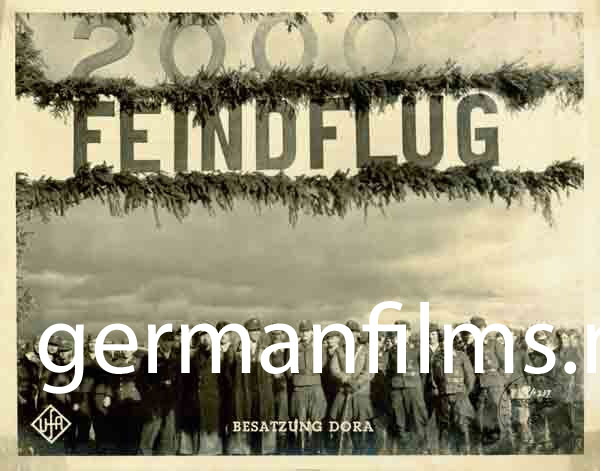
As at September 2016, our Collection has 13 lobby cards (AHFs) and seven press photos from Besatzung Dora. Stills from the film are exceedingly rare. The Bundesarchiv–Filmarchiv in Fehrbelliner Platz in Berlin has but 5 press photos from the film, and no lobby cards.

In December, 2014, the extremely rare privately–printed book just for members of the Air Reconnaissance 5. F. / 123 Squadron serving in France, Kriegsweihnacht 1942, (the Luftwaffe Staffel 123 Zum Geleit von Hauptmann und Staffelkapitan Armin Goebel was found and purchased, which contains the 20 June 1942 official entry on the visit and subsequent filming of scenes for Karl Ritter's Besatzung Dora at the Staffel's Buc airfield near Versailles, and quoted in translation in the book on Ritter.
IN SUMMARY: the research, quoting for the first time from Karl Ritter's private diaries about the banning of the film, and using other previously overlooked Ufa film archive files, appears in Chapter 5 of the 2nd edition of Karl Ritter – His Life and 'Zeitfilms' under National Socialism, published in Australia in 2014 and is available here. The chapter on Besatzung Dora in the Karl Ritter book is the most comprehensive and detailed information on the film and the background to the banning of the film ever published in any language.
****** RESEARCH on Besatzung Dora is continuing –– if you have any original film materials, film stills, or "behind-the-scenes" private photographs on this film, please contact us, as we would be interested in acquiring anything of this nature for this Collection. Thank you.
Deutscher! RECHERCHE über Besatzung Dora geht weiter...sollten Sie etwas über den Spielfilm anzubieten haben (d.h. Standfotos, Pressefotos, Werbungen, Privataufnahmen vom Drehtage) .... bitte uns kontaktieren! Besten Dank im Voraus!
-------------------------------------------------------------------------------------------------------------------
The Making of The Crew of the Dora
Our research on the film The Crew of the Dora / Besatzung Dora (1943) has resulted not only in a full chapter on the film in our 2nd edition KARL RITTER biography (©2014-2015) but now, as well, a full–length book on the fascinating story of the making of this WWII combat feature film, using the unpublished diaries of director Karl Ritter. Some 50,000 words from his diary from 1942 – 1943 are translated into English and used to tell the story of this remarkable film adventure -- filming in Occupied France, in wartime Berlin, in the Soviet Union 85 miles south of the Siege of Leningrad for a month, in wartime Italy.... the only feature film of the Third Reich ever to be produced inside active war fronts and behind Partisan lines! With 90 photographs/sketches/ maps and 320 pages, it is the most comprehensive study of this film ever written, using primary sources never before quoted until now!
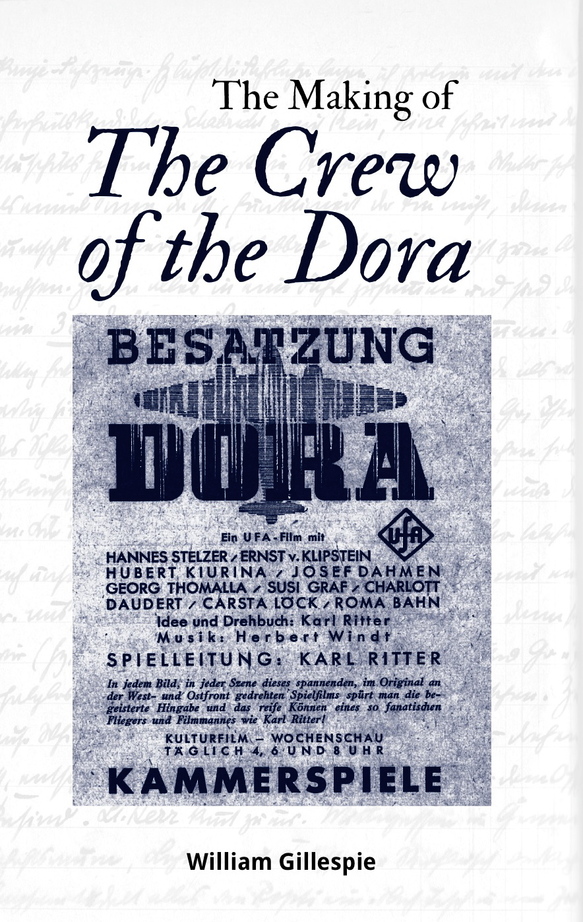
The book is now available to sell within Australia to customers with an Australian shipping address at €20 postpaid (about AUD$30) via our Poster Shop. The price includes the cost of air freighting copies to Australia from the USA, as well as AUD$13.95 domestic postage within Australia. The book weighs over 500 grams and does therefore does not qualify for Letter Rate, and higher postal charges apply. LIMITED AVAILABILITY. Foreign customers please check the website of International Historic Films in Chicago, USA. Foreign orders will be fulfilled from the USA at the retail price of US$29.95, plus postage charges there.

